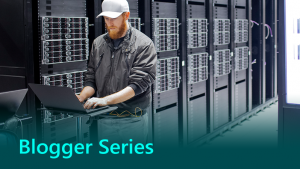
How modern cybersecurity helps you stay productive and resilient
 The speed at which many organisations responded digitally over the last few months has caused many to change their approach to cybersecurity. Alongside this, security and customer trust are becoming more important for your organisation’s reputation. Now, more than ever before, is it important to consider a modern cybersecurity strategy. One that keeps your data and your customer’s data safe while helping your employees work together.
The speed at which many organisations responded digitally over the last few months has caused many to change their approach to cybersecurity. Alongside this, security and customer trust are becoming more important for your organisation’s reputation. Now, more than ever before, is it important to consider a modern cybersecurity strategy. One that keeps your data and your customer’s data safe while helping your employees work together.
We’ve been helping customers for a long time with securing their remote working practices to enable productivity from anywhere. A Forrester and Microsoft survey found organisations can find it difficult to balance security and productivity. Modern tools, however, have improved the customer experience for 86 percent of enterprises and streamlined business processes for 77 percent.
Cybersecurity and productivity
There’s a stereotype that security ‘locks the box’ and makes it difficult for everyone, not just cybercriminals, to access what they need. This approach may help stop criminals from accessing your data. However, it also might tempt employees to circumnavigate or ignore secure process just to get work done. Employees want to be able to work well together from anywhere. A modern cybersecurity strategy uses an integrated security platform. A good way to do this is with a zero-trust approach that authenticates, authorises, and encrypts every access request. Look for tools and apps with built-in security that uses this approach. Your employees can get on with critical tasks while your security systems work in the background. They also can take advantage of intelligence and analytics to detect and respond to anomalies in real time. A Forrester study found that using tools and devices that take this approach, such as Surface and Microsoft 365, saves organisations 17 percent in endpoint security spend. They also reduce annual security breaches for Surface by 20 percent.
Robert Walters, took this approach, focussing on securing user identities and endpoint devices to enable their people to do their work, quickly and securely, from anywhere. Their employees can securely access tools and apps that help them work together from anywhere in the world. Meanwhile, their IT team can quickly manage user access, and ensure company and customer data is kept secure and compliant.
Adapt to a changing cybersecurity landscape
Cyberthreats are constantly evolving, and there can be pressure for organisations to stay ahead of them. It can be difficult for organisations to have the time, money, and people to do this. But that is where modern cybersecurity comes to your aid. Forrester found that Microsoft Defender ATP automatically remediates 97 percent of endpoint attacks detected. It draws data and analytics from your organisation and over 8 trillion threat signals per day to help protect against a changing threat landscape. This frees up time for your IT team to focus on more critical tasks.
When BP developed its security principles, it did so with the knowledge that its needed to ensure they scale and adapt as cyberthreats advance. By using cloud security like Azure, they can take advantage of intelligent, multi-layered security across physical data centres, infrastructure and operations. They are able to get quick and real-time insights of their security posture. This means they can safeguard identity, data, networking, and apps simply and quickly.
Empowering employees
 For BP, their key security principle is that “everyone is responsible for security.” At Microsoft, we also believe that an important part of modern cybersecurity is educating employees on the risks and threats. Without the visual perimeter of an office and traditional on-premise environments, employees are more open to looking at how they can protect their work and data remotely.
For BP, their key security principle is that “everyone is responsible for security.” At Microsoft, we also believe that an important part of modern cybersecurity is educating employees on the risks and threats. Without the visual perimeter of an office and traditional on-premise environments, employees are more open to looking at how they can protect their work and data remotely.
Ensure employees understand cybersecurity and are actively using built-in security tools, such as multi-factor authentication. Educate them on how built-in security tools actually help make them more productive instead of being a hinderance.
Innovation and resilience
A modern approach to cybersecurity, with tools that have built-in protection, makes it easier for your employees to work together, from anywhere. Take advantage of AI and automation to free up your security and IT teams. They will then have more time to focus on value-add work, delivering innovation to your organisation. This means business critical work can keep going even if your employees aren’t in the office, securely.
Find out more
Remote secure working best practices
Cybersecurity workshop training
Join the conversation at Envision
Digital technology is changing not just how organisations operate but how leaders lead. Join us at Envision, where executives across industries come together to discuss the challenges and opportunities in this era of digital disruption. You’ll hear diverse perspectives from a worldwide audience and gain fresh insights you can apply immediately in your organisation.
Connect with leaders across industries to get relevant insights on leadership in the digital era.
Resources for your development team
Security best practices and guidance
Microsoft Learn for Security Engineers
About the author







